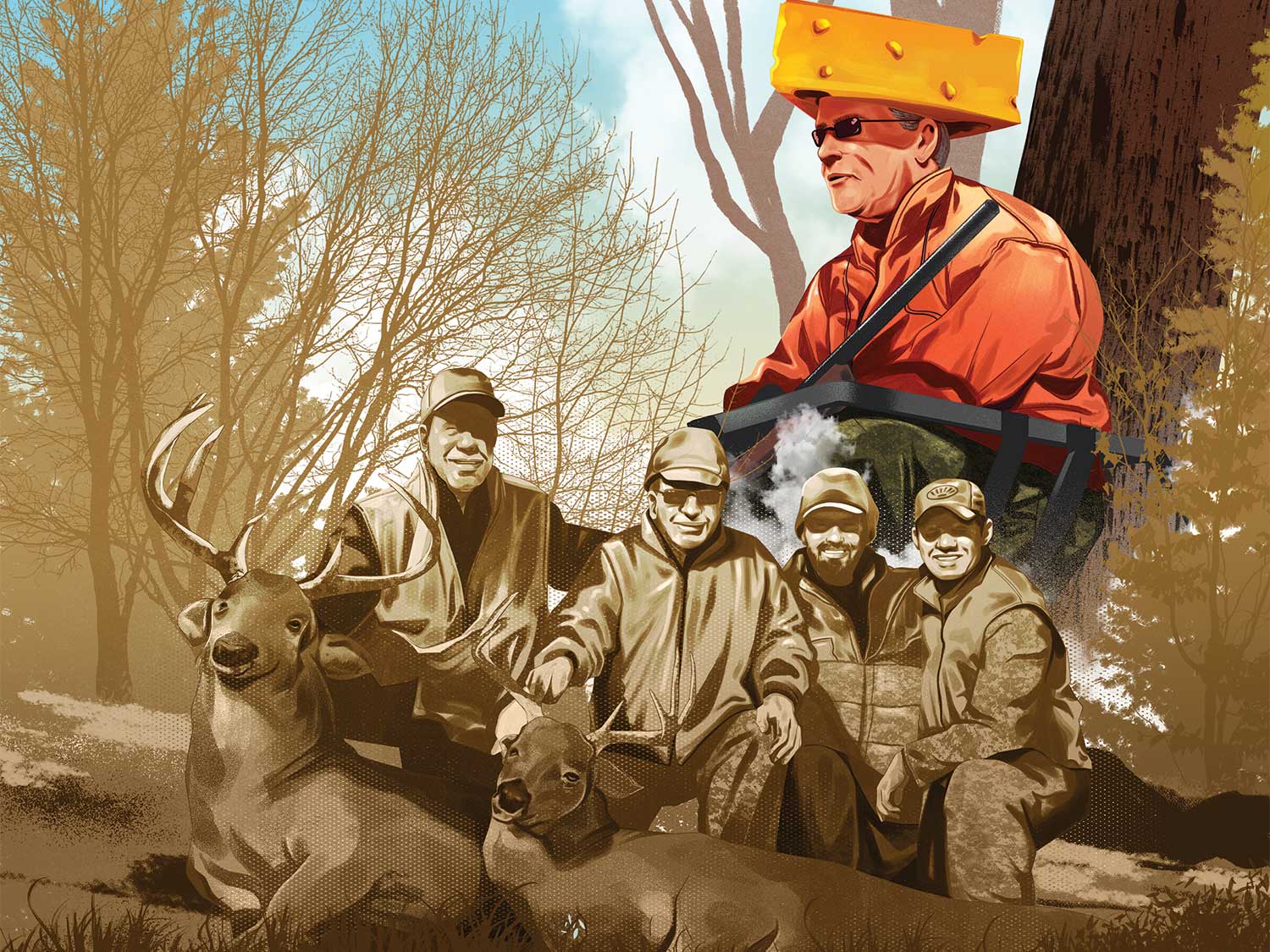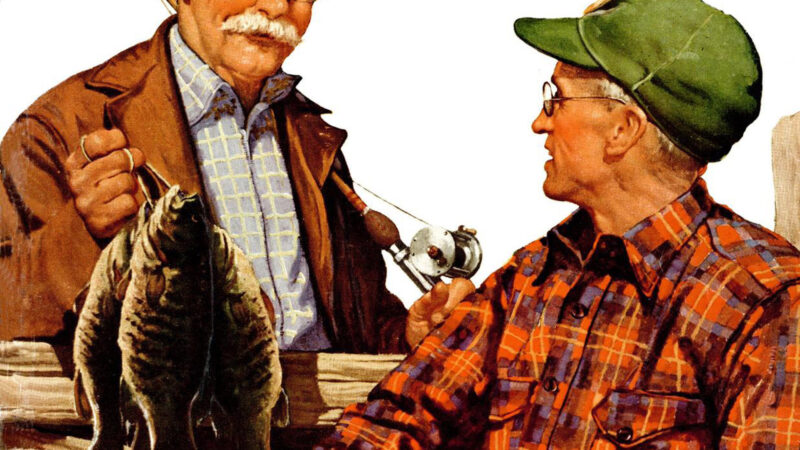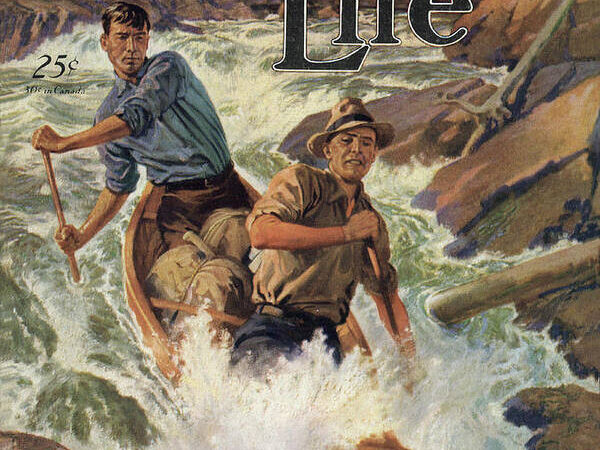How to Hunt Deer Like a Cheesehead

The boom comes from the southeast, and it’s loud enough to startle me in my treestand. On opening day of deer season in northern Wisconsin, the woods come alive with gunfire: soft pops in the distance, sharp cracks from the neighbors’ properties, and hurried four- or five-shot strings from someone hammering away with a lever gun at deer bounding across a cornfield. But a bang loud enough to reverberate off the tree I’m sitting in? That has to be Grampa’s .300 Win. Mag.
This is my twentieth season hunting our family land—a few hundred acres of mixed timber where we pack in four or five Robinsons each fall weekend to hunt deer. Because there’s limited room to roam, we all have designated stands that change only occasionally from year to year. Gramps has been hunting the same 3 acres for more than a decade.
This deer hunting strategy—sitting in your stand day after day until you kill a deer or the season ends—is the polar opposite of the highly mobile trend of tree saddles and cellular trail cameras. Today’s run-and-gun deer hunter must be agile and adaptive, constantly reading conditions and efficiently changing setups. And sure, that style of hunting can be fun and effective. But at our camp, change comes more slowly.
A few years ago, for example, I tried to get everyone to use trail cameras. While they all agreed it was cool to see pictures of deer and other wildlife, the consensus was that the cameras kind of ruined the magic of it all. My dad said that if he knew a big buck was out there, then killed a smaller buck, he might feel disappointed. And when I brought a new pour-over coffeemaker to camp, I upset the long tradition of our blue enamel percolators, which either take too long to perk or heat too quickly and boil over. Even though they’re the source of constant bickering each morning, I was ridiculed as some kind of newfangled French barista. (Explaining that the pour-over method was invented by a German woman in the 1900s didn’t help my case.)
Two years ago, Gramps shot a small buck with his .300 but didn’t have the gun mounted solidly to his shoulder. The scope slammed into his face and busted his nose so badly he had to check into the ER to stop the bleeding; that summer, my dad and my uncle Pat tried to talk Gramps into shooting a .243. But on opening weekend Gramps had his big .300 back at camp.
“Ack, don’t be wimps,” he said, ignoring everyone’s looks of concern. “It’s just a little kick.”
You could view this never-change attitude as a special kind of stubbornness. Or, more generously, the best kind of perseverance. This is the same attitude that has allowed three generations of Robinsons to master the art of sitting in the woods. That might sound unimpressive because, of course, almost all hunters sit in the woods. But when I got older and started deer hunting with folks outside my family, I noticed subtle differences in how other people hunted. Other deer hunters bring books to read in their blinds or look at their phones to fight boredom. They shuffle around in their seats, sneak naps, and check their watches. Anything to pass the time, like they’re trying to fast-forward the hunt to the good parts. I suspect these are the same people who complain that they’re too busy and that the days fly by too quickly.
But when the Robinsons are deer hunting, we don’t want time to pass. We’re happy to watch a squirrel or a grouse, or just listen to the geese migrate until it’s time for lunch, a buck appears, or the sun sets on the day.
I’ve had the opportunity to interview some of the best deer hunters in the country, and they’ve shared mountains of tactics and knowledge with me. But I learned the big lesson, the one that matters most, at our family deer camp as a kid. There’s real value in sitting still, being quiet, and happily waiting for a thing that may never come.
Read Next: The Case for New, Wood-Stocked Deer Hunting Rifles
Good Times
At lunchtime I climb down, fire up my four-wheeler, and drive to Grampa’s stand. My cousin Shawn pulls up at the same time, and we walk toward the voices we hear echoing through the popple. We find my dad, who beat us there, and Gramps standing over a beautiful 10-point with a golf ball-size hole blown through its chest. Gramps tells the story with a look on his face that I can only describe as, “See, told ya.”
Dad casually mentions that he also killed a buck that morning, so once we get Gramps’ deer to camp, he and I set out to retrieve it. From maybe 80 yards away I can see a massive rack sticking up from the fallen leaves.
“Holy smokes,” I mutter as my dad hoists the antlers of an enormous northwoods 8-pointer. It’s the best buck he’s ever killed, and also the largest buck we’ve ever taken—or even seen—on our land. “He’s a pretty nice one,” he tells me as we lash the buck to his wheeler. “But I didn’t want to take away from Grampa’s big moment.”

By next fall, 80-year-old Gramps will be one year older, and my dad will have major back surgery that limits his hunting for the season. Change will come for the Robinson deer camp whether we like it or not.
But now isn’t the time to worry about any of that. We have to hang the bucks on the meat pole and get the brats ready for lunch. That, after all, is our tradition.
The post How to Hunt Deer Like a Cheesehead appeared first on Outdoor Life.
Articles may contain affiliate links which enable us to share in the revenue of any purchases made.
Source: https://www.outdoorlife.com/story/hunting/how-to-hunt-like-a-cheesehead/





